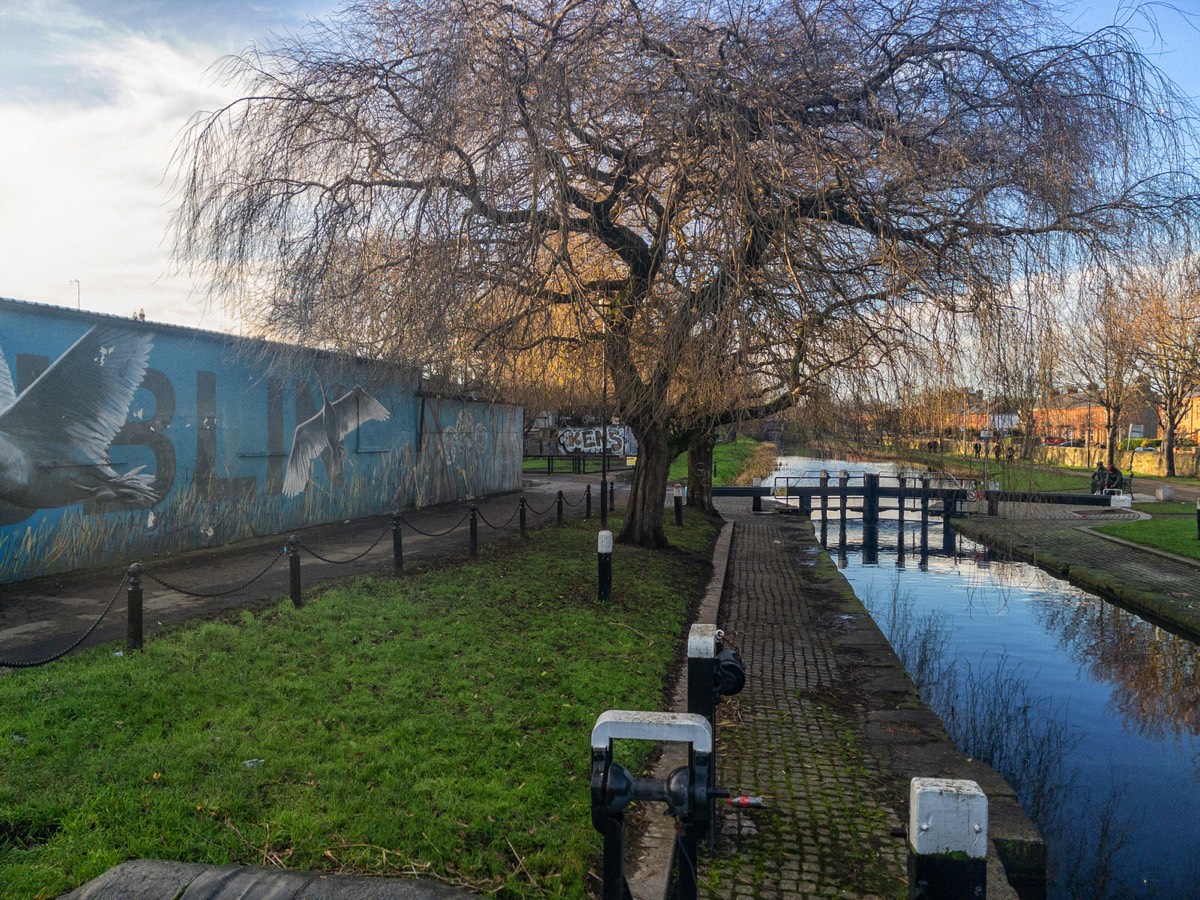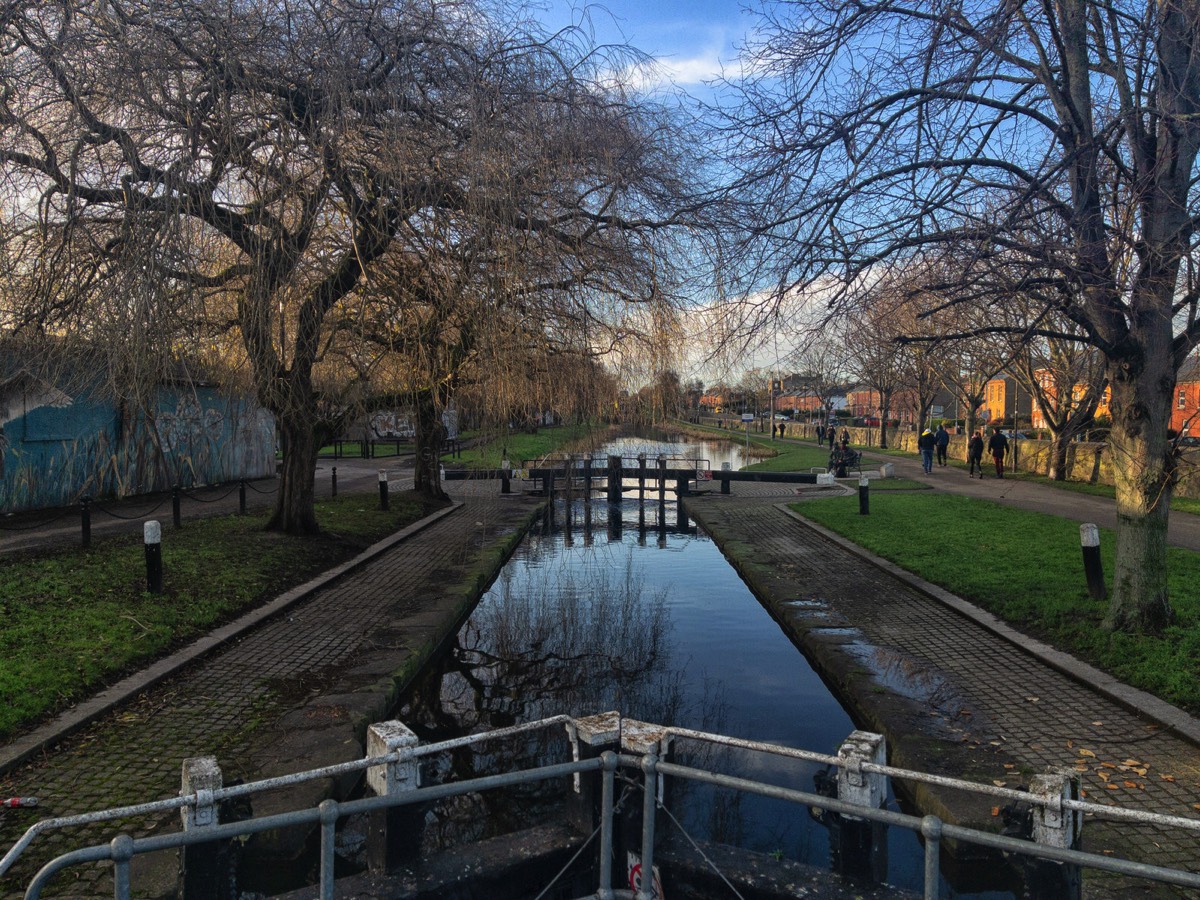2ND LOCK ON THE ROYAL CANAL AS SEEN FROM BINNS BRIDGE DRUMCONDRA
Almost everything in Ireland has a story and Binns Bridge is a typical example.
The Royal Canal had an interesting board of directors. One of the most notable was Napper Tandy, less well known were John Binns who was branded a ‘a jobbing demagogue’ and William Cope who was nicknamed ‘the shoemaker’. The directors were dismissed and Binns and Cope but not before they had bridges named in their honour.
The canal lock featured in this photograph forms part of a group of three double canal locks (2nd Lock, 3rd Lock and 4th Lock) located between Binns Bridge at the southeast and Westmoreland Bridge at the northwest. Construction of the Royal Canal began in the late eighteenth century to provide freight and passenger transport between the Dublin and the River Shannon. The chambers exhibit good quality stone masonry with fine joints. The well-built double locks have attractive sloping edges to cope with the change in height between the lower, middle and upper levels. On either side of the lock, the canal expands in width to provide a mooring place for waiting boats. The 2nd Lock is complemented by the nearby Binns Bridge to the east.
John Binns (died 1804) was an Irish Patriot politician and a member of Dublin Corporation.
Binns was a wholesale silk merchant of Dame Street, Dublin, working in partnership with William Cope. Both Binns and Cope became members of Dublin Corporation as representatives of the Guild of Merchants alongside such notable figures as James Napper Tandy and Lundy Foot, but whereas Cope's initial support for reformist opposition politics gave way to a strong reaction against Catholic emancipation, Binns allied with Tandy to push for radical reform of the Irish political system and they organised an assembly of Volunteers to lobby for Catholic emancipation in 1784. The same year, the Freeman's Journal reported an entirely fictitious plot by the Hell Fire Club to bring general chaos and lawlessness to Ireland, supposedly signed by “J. N. T__dy, Secretary” and “J__n B__ns, Treasurer”. A tall man, Binns was known to reformers as 'Long John Binns', but to government supporters as 'the devil's darning needle'.
Binns, Tandy and Cope were all heavily involved in the financing of the Royal Canal and served on its board of directors, and Binns had bridges over both the Grand Canal and the Royal Canal named in his honour. Cope also had a bridge named after him. Tandy was forced to flee Ireland in 1793 due to his involvement with the revolutionary Society of United Irishmen, while Cope became a paid government spy against the same organisation. However, the Royal Canal project became severely indebted and both Binns and Cope were dismissed from the board in 1802. Financially ruined, John Binns died in 1804.
His brother, Jonathan Binns, was the father of thirty two children and the grandfather of United Irishman agitator turned American journalist John Binns.
James Napper Tandy (16 February 1739 – 24 August 1803) was a United Irishmen who experienced exile, first in the United States and then in France, for his role in attempting to advance a republican insurrection in Ireland with French assistance.
On 12 February 1800, Tandy was put on trial at Dublin and was acquitted. He remained in prison in Lifford Jail in County Donegal[6] until April 1801, when he was tried for the treasonable landing on Rutland Island. He pleaded guilty and was sentenced to death but he was reprieved and allowed to go to France.
This leniency may have been partly due to doubts as to the legality of the demand for his surrender by the Hamburg authorities. Moreover, Napoleon vigorously intervened on his behalf and is even said to have made Tandy's release a condition of signing the Treaty of Amiens.
Notwithstanding his vices and his lack of all solid capacity, there is no reason to suppose that Napper Tandy was dishonest or insincere; and the manner in which his name was introduced in the well-known ballad "The Wearing of the Green" proves that he succeeded in impressing the popular imagination of the rebel party in Ireland. In France, where his release was regarded as a French diplomatic victory, he was received, in March 1802, as a person of distinction; and when he died on 24 August 1803 in Bordeaux, his funeral "was attended by the whole army in the district and an immense concourse of citizens". There are suggestions that Tandy's remains were later exhumed and returned to Ireland, being buried secretly in an unmarked grave at Castlebellingham Parish Church in Co. Louth (his niece, Anne Tandy, had married into the Bellingham family). His widow was buried at St. Mary's churchyard, Julianstown, Co. Meath, where an inscription reads: "To the memory of Mrs Ann Tandy, died 25 Dec 1820, widow of James Napper Tandy, Irish Patriot and General French Army. This stone was erected by their son James Napper Tandy whose youthful son was buried here with Thomas Cannon..."


Commercial DisclosurePLEASE NOTE THAT LINKS BELOW MAY REDIRECT YOU TO THE AMAZON LOCATION MOST LIKELY TO SHIP TO YOUR ADDRESS
You will find links to buy products from Amazon, Google and other partners. If you click on these links, you’ll find that the URL includes a small extra piece of text which identifies that the click came from my websites. This text is an affiliate code, and it means that I get a small percentage of the money you spend if you choose to buy that product, or, in some cases, other products from the site soon after. These affiliate links help pay the costs of producing my websites and ensure that the content is free to you.

Sony SEL90M28G FE 90mm f/2.8-22 Macro G OSS Standard-Prime Lens
THIS IS MY FAVOURITE LENS
A perfect match for α7 series, 35mm full-frame E-mount cameras, 90mm Macro with a bright F2.8 maximum aperture, Nano AR coating effectively suppress reflections, Dust and moisture resistant design Minimum Focus Distance : 0.92 ft (0.28 m), Maximum Magnification ratio : 1.0x, Focal Length : 90 mm. The angle of view is 27 degree (35 mm) and 17 degree (APS-C) Optical Steady Shot image stabilization for handheld shooting, Instant manual/auto focus selection via a sliding focus ring, Instant manual/auto focus selection via a sliding focus ring Corner to corner sharpness w/ Advanced Spherical elements, Super ED glass w/ multi‐coating reduces flare and ghosting, 9-blade circular aperture contributes to gorgeous bokeh Direct Drive SSM (DDSSM) for quiet, precise focusing; Weight: 602 g (21.3 oz)
THIS WAS MY FIRST SONY PRIME LENS
COPYRIGHT INFORMATION BELOW APPLIES ONLY TO PHOTOGRAPHS

This work by William Murphy aka Infomatique is licensed under a Creative Commons Attribution-NonCommercial-ShareAlike 4.0 International License.
Permissions beyond the scope of this license may be available at https://excellentstreetimages.com/in-the-year-twentytwenty/copyright/.











